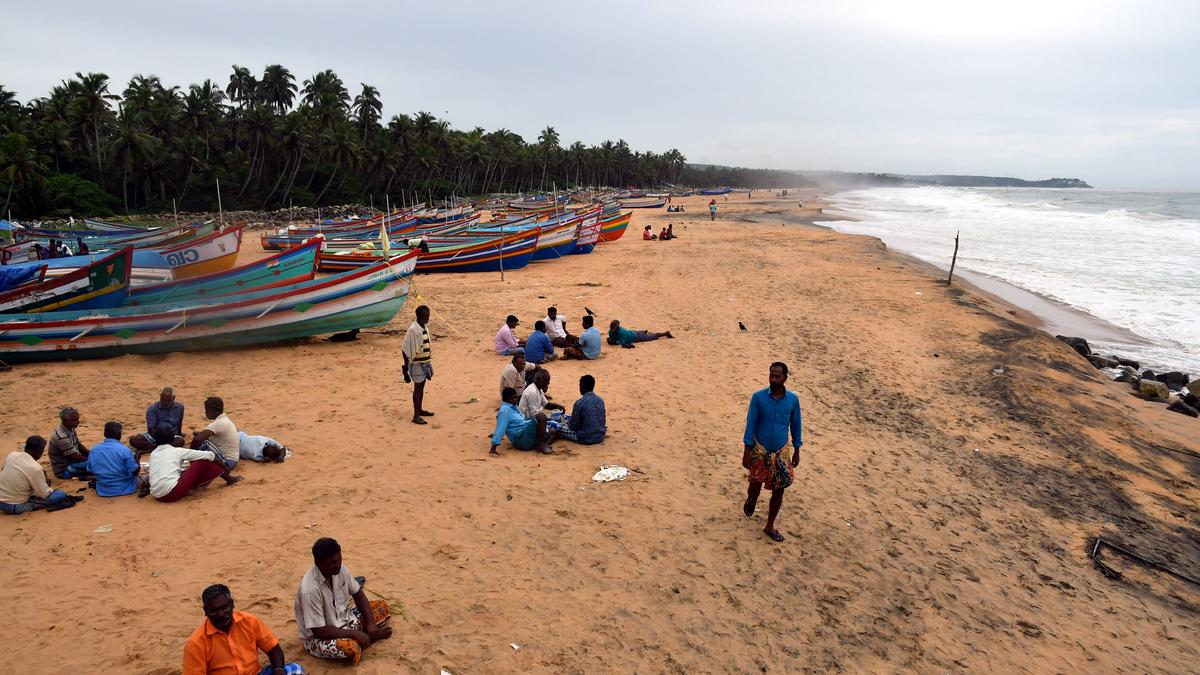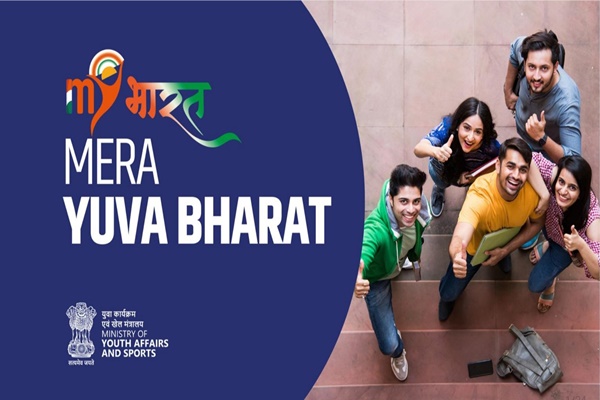Geotubing

- 14 May 2025
In News:
A joint study conducted by the National Institute of Ocean Technology (NIOT) and the Kerala State Coastal Area Development Corporation (KSCADC) has confirmed the effectiveness of geotubing-based offshore breakwaters in managing coastal erosion at Poonthura, Kerala. The installation not only mitigated shoreline erosion but also contributed to sustainable beach formation—highlighting the method's potential for broader coastal protection strategies.
What is Geotubing?
Geotubing involves the use of large geotextile tubes, filled with sand or slurry, which are strategically placed underwater to reduce wave energy and prevent shoreline erosion. At Poonthura, three vertical layers of 15-meter circumference geotubes were installed perpendicular to the coast, forming submerged breakwaters that trap sediment and promote natural sand deposition.
Materials and Construction
- Geotubes Composition:Constructed from high-performance woven geotextiles, typically made of polypropylene (PP) or polyester (PET).
- Material Properties:These fabrics are designed to be permeable, durable, and resistant to UV radiation, chemical exposure, and microbial degradation, making them well-suited for long-term marine use.
Key Functional Features
- Wave Energy Dissipation:Submerged geotubes act as barriers that absorb and deflect wave energy before it reaches the shoreline.
- Beach Nourishment Support:By slowing wave action, the geotubes encourage natural sand accumulation, supporting beach regeneration.
Advantages of Geotubing
- High Durability:Withstands tensile stress and harsh environmental conditions, including chemical and biological exposure.
- Environmentally Friendly:Geotubing is non-toxic and contributes to coastal and wetland restoration without polluting ecosystems.
- Cost-Effective:More economical than traditional concrete or steel structures and easier to install, particularly in remote or variable terrains.
- Customizable Design:Geotubes can be tailored in size and configuration to suit specific project requirements and geographical conditions.
- Multi-Functional Utility:Beyond coastal defense, geotubes are effective in flood management, riverbank stabilization, sludge dewatering, and landfill containment.
Broader Applications of Geotubing
- Coastal Protection:Used in breakwaters, seawalls, and dune reinforcement projects.
- River and Lake Management:Effective for stabilizing riverbanks and controlling sedimentation.
- Wastewater Treatment:Applied in industrial and municipal dewatering processes.
- Infrastructure Support:Utilized in the construction of roads, railways, ports, and reservoirs.
- Environmental Remediation:Useful for site isolation, pollution control, and ecosystem restoration.
MY Bharat Portal

- 14 May 2025
In News:
During a recent address in Patna, the Union Minister called on India’s youth to actively engage with the ‘MeraYuva Bharat (MY Bharat)’ portal. Emphasizing the critical role of young people in shaping the nation’s future, he encouraged them to become active participants in developmental initiatives and contribute meaningfully to the country’s progress.
About MY Bharat Portal
What is MY Bharat?
Launched on October 31, 2023—the birth anniversary of Sardar Vallabhbhai Patel—MeraYuva Bharat (MY Bharat) is an autonomous institution under the Ministry of Youth Affairs and Sports. It serves as a technology-driven, institutional platform designed to empower youth and enable youth-led transformation across India.
Objectives of MY Bharat
- Promote inclusive and active youth participation in nation-building activities.
- Prepare young individuals to be agents of change during Amrit Kaal, aligning with the vision of Viksit Bharat@2047.
- Ensure equal access to opportunities for learning, volunteering, and mentorship.
Key Features of the Portal
- Volunteer Mobilisation:Enables youth to engage in public welfare initiatives, disaster relief operations, and awareness campaigns across various sectors.
- Digital Youth Profiles:Participants can create profiles to showcase their skills, interests, and experiences, helping them connect with relevant programs and organizations.
- Experiential Learning Opportunities:Facilitates hands-on project work with local governments, private enterprises, and NGOs, offering real-world exposure.
- Mentorship and Peer Networking:Provides structured access to experienced mentors and national peer networks, fostering guidance and collaboration.
- Government Scheme Awareness:Empowers youth to act as grassroots ambassadors, promoting awareness of various government schemes within their communities.
State of the World’s Nursing 2025
- 14 May 2025
In News:
The World Health Organization’s upcoming “State of the World’s Nursing 2025” report raises an urgent alarm over the deepening global nursing shortage. It projects that by 2030, 70% of the global shortfall will be concentrated in Africa and the Eastern Mediterranean regions, underscoring the need for immediate and strategic workforce interventions.
Nursing in India: Current Status and Challenges
India is grappling with a critical shortage of nursing professionals, falling short of global standards in several key areas:
- Nurse-to-Population Ratio:India currently has approximately 30 nurses per 10,000 people, which is below the WHO-recommended threshold of 44.5 health workers per 10,000.
- Nursing Education:While the country has significantly increased the number of nursing graduates, quality concerns, infrastructure limitations, and faculty shortages persist across institutions.
- Migration Trends:India remains one of the leading exporters of trained nurses, especially to countries like the UK, Gulf nations, and Australia, contributing to a domestic workforce drain.
- Workforce Retention:Persistent issues such as low wages, limited opportunities for career advancement, and unsafe or stressful working environments contribute to high attrition rates.
Key Issues in India's Nursing Sector
- Inadequate Workforce Availability:India does not meet the WHO’s benchmark for health worker density, with rural areas facing the most severe shortages.
- Urban-Rural Imbalance:A large concentration of nurses in urban private hospitals severely restricts healthcare access in Primary and Community Health Centres (PHCs and CHCs) in rural regions.
- Poor Working Conditions:Nurses frequently endure long working hours, delayed salaries, insufficient mental health support, and unsafe work environments, which discourage long-term retention.
- Lack of Leadership Representation:The absence of Chief Nursing Officers (CNOs) at both state and national levels weakens the profession’s influence in health policy and governance.
- Limited Public Investment:Constraints in fiscal capacity and inadequate infrastructure hinder both the training and employment of nursing professionals.
- International Migration Without Compensation:The high rate of nurse outmigration is not matched by equitable bilateral agreements, leaving India's healthcare system vulnerable and under-resourced.
Strategic Recommendations:
- Expand Training Infrastructure:Increase the number of nursing colleges with a focus on faculty recruitment and clinical infrastructure, in line with the National Education Policy’s emphasis on vocational education.
- Strengthen Leadership and Governance:Establish Chief Nursing Officers at state and national levels, and bolster the role of nursing councils to advocate for reforms and oversee standards.
- Enhance Retention Strategies:Improve remuneration, ensure workplace safety, offer mental health support, and create clear career progression pathways to retain talent.
- Promote Rural Deployment:Introduce bonded scholarships, financial incentives, and housing support to encourage nursing professionals to serve in underserved rural regions.
- Leverage Technology and AI:Incorporate blended learning models, train nurses in electronic health record systems, and integrate AI-driven modules into nursing curricula for future-ready skills.
- Foster Fair International Cooperation:Develop bilateral agreements (e.g., India–UK healthcare MoUs) that ensure reciprocal benefits and support domestic capacity-building when nurses migrate abroad.
Raika Tribe
- 14 May 2025
In News:
The Raika community's deep-rooted knowledge of pasture cycles, animal health, and biodiversity continues to play a vital role in sustaining the delicate ecological balance of Rajasthan’s arid regions.
Who are the Raikas?
The Raika tribe, also known as Rabaris, is an indigenous pastoralist community predominantly residing in the arid and semi-arid landscapes of Rajasthan, especially around Kumbhalgarh in Rajsamand district.
Their identity is intricately linked to camel herding, particularly the breeding of the hardy Marwari camel—a breed renowned for its strength, endurance, and adaptability to desert conditions.
Cultural and Ecological Significance
For the Raikas, camel herding is more than just a livelihood—it is a way of life. Their cultural practices, seasonal migrations, and oral traditions are closely tied to their pastoral role.
Over generations, they have cultivated extensive traditional knowledge about:
- Pasture Cycles: Insight into optimal grazing periods and routes to maintain vegetation health.
- Animal Health: Natural methods to ensure the well-being of livestock, particularly camels.
- Biodiversity Management: Sustainable herding practices that promote ecological resilience.
Their traditional migratory routes enable camels to graze on medicinal desert plants, which not only improve animal health but also contribute to preserving the region’s unique biodiversity and ecological stability.
PL-15 Missile
- 14 May 2025
In News:
Amid rising tensions between India and Pakistan, a fully intact Chinese-made PL-15 long-range air-to-air missile has reportedly been recovered in Hoshiarpur, Punjab. The incident has sparked security and strategic concerns, given the missile's advanced capabilities and origin.
Overview of the PL-15 Missile
Also known as the "Thunderbolt-15," the PL-15 is a cutting-edge beyond-visual-range air-to-air missile (BVRAAM) developed by China’s 607 Institute and produced by the China Aerospace Science and Industry Corporation (CASIC). It is specifically designed to engage enemy aircraft at extended distances, far beyond the visual range of the launching platform.
Key Features:
- Propulsion and Speed:The missile is powered by a dual-pulse solid-propellant rocket motor, enabling it to reach speeds of over Mach 5.
- Range Capabilities:The domestic Chinese version has an estimated operational range of 200 to 300 km. The export version, the PL-15E, is officially rated for a maximum range of 145 km, though in practice this may be limited to 100–120 km depending on the launch conditions and platform.
- Warhead:It carries a high-explosive fragmentation warhead weighing between 20 and 25 kg, engineered to effectively neutralize maneuvering aerial targets.
- Guidance System:The PL-15 is equipped with an advanced guidance package that includes:
- Inertial navigation
- Beidou satellite updates
- Two-way datalink for real-time mid-course adjustments
- Terminal active radar homing with an AESA (Active Electronically Scanned Array) radar seeker
